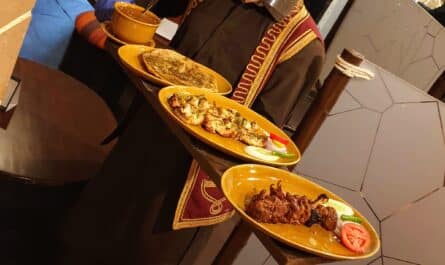A question I ask myself on every farm visit – “How did people farm before Google Lens??” No, do not laugh. I am serious! Yes, yes. I know all about acquiring knowledge through experience and wisdom being handed down through generations and learning by engaging with the community. But none of these work for The Two Bandra Girls. At least, not all the time.
Take, for instance, the time we saw beautiful flowers growing all over the farm. The Marathi name made absolutely no sense to us, and we were distressed to see Farm Consultant M dismiss the pretty flowers as a monsoon menace. Google Lens to the rescue and, et voila, we learnt that they are wild turmeric flowers. When we dug carefully below the pretty flower, we discovered the fragrant turmeric rhizome.
Or the time we saw this gorgeous blue scorpion that Google Lens promptly identified as the Heterometrus Spinifer or the giant blue scorpion.
Similarly, this stunning fellow below is the Peninsular Rock Agama.
And this little fellow is the Beddome’s keelback, also known as the Nilgiri Keelback.
And, when Google Lens is confused or not helpful, there is always Bright Sun Surya, our friend and, (I believe) India’s best naturalist. He patiently and promptly identifies creatures and plants that I regularly WhatsApp to him. He too should be thanking Google Lens for identifying so many creatures and plants and limiting my “who dis?” messages to him😊
This butterfly was promptly identified as the Peacock Pansy.
And this lovely pot gifted to us by Farm Manager M was identified as the Marvel of Peru or the 4 o’clock plant.
We extensively use Google Lens when we are confused about the identity of saplings we have planted and to identify local vegetables that grow in abundance in distant corners of the farm.
A few months ago, the Imp and his Lady harvested a large basketful of a vegetable we were sure we had not planted. Did birds drop these seeds? Did the Imp and his Lady munch on these while farming and discard the seeds? We asked but received no real answers and again, they identified the vegetable with a name we had never heard. Google Lens to the rescue, and we found we had a large harvest of Malabar Cucumber!
Last month though, Google Lens truly saved the day.
We had planted a large bed of tomatoes amongst other vegetables. They were thriving and we delighted in seeing the hundreds of tiny green tomatoes grow and bloom on each farm visit. We received daily pictures of our flourishing vegetables, and we could not wait to harvest them. Then suddenly, we received no updates for three days and all questions were met with a stony silence. After several calls we were told there was a problem with the tomato plants. This was seriously sad news. I insisted they send me a picture of the problem and after some hesitation the Imp sent me the picture you will see below.
Bandra Rose, Mr Stonethrower and I had these horror visions of hundreds and thousands of rotten tomatoes strewn all over the farm and were very discouraged. On an impulse, I used Google Lens on the picture and found our tomatoes were suffering from Blossom End Rot (BER). Further investigation revealed that BER is a physiological problem, caused by adverse growing conditions rather than a pest or disease. Tomatoes are particularly susceptible to BER. And, while we could not reverse the damage on the tomatoes that had already succumbed, we could take quick action to save the rest of our crop.
Cut a long series of phone calls, messages, and Google research short, and what our tomatoes needed was an instant dose of calcium and more regular and timely watering.
This done, the Two Bandra Girls Organic Farm was soon blessed with over 50 kilos of gorgeous, sweet tomatoes. On one of our farm visits with Arch Angel, we bit into a tomato that we had just picked. The taste was startlingly different from what we get at home. The tomato was sweet, extremely juicy, and very vegetal in taste. This could be because of them being a different variety, being organic or just being just so fresh, I have no idea. Bandra Rose was adamant that the tomatoes be turned into a sauce, not ketchup, but a Marinara Sauce – the red sauce that defines Italian food. Mr. Stonethrower was put in charge of making the sauce.
There were several options on how the tomato could be treated. A call was made to our friend who imports Italian catering equipment to enquire about a tomato crushing machine. These crafty Italians have devised a machine, which is something like a Kheema Machine where you put the tomato in, it gets crushed, the juice come out one side and the seeds and skin gets expelled. To our disappointment, he had no machines for sale. His entire stock was sold out. Apparently, many restaurants in India buy this machine to make the tomato puree that is used in Punjabi/Mughlai food. Mr Stonethrower decided that the first batch of sauce would be made from 10 kilos of tomato using the whole tomato – skin, seeds and all.
The first job was to get a large enough vessel to cook the sauce. Then the tomatoes were washed, cored, and chopped. 400 grams Garlic [for 10 kilos of tomato] were blended till smooth. 1 kilo of onion was chopped. A handful of dried Bedgi chillies were deseeded and blended. Olive oil was heated and the onion, garlic cooked down. In went some red wine, the Bedgi Chilli and finally the chopped tomato. This was cooked for approximately two hours. Once the sauce had thickened, in went loads of Oregano and fresh Basil. The sauce was then blended using a stick blender. Seasoning adjusted and the Two Bandra Girls, ‘World ka Best Marinara Sauce’ was ready for bottling.
While the sauce was cooking, 500-gram food-grade glass bottles were washed and sterilized by heating them for 30 minutes in a 110C oven. The boiling-hot sauce poured into the hot bottles, quickly capped and left to cool. Once cooled the bottles were labelled and ready for distribution.
The other 40 kilos of tomatoes were sauced and bottled over the next few weeks and to date, the Two Bandra Girls have given friends and family almost sixty bottles of delicious Marinara sauce.
And to think, there would have been no tomatoes or Marinara Sauce if Google lens had not identified the Blossom End Rot!




The marinara is seriously world ka best…. Thank you ❣️